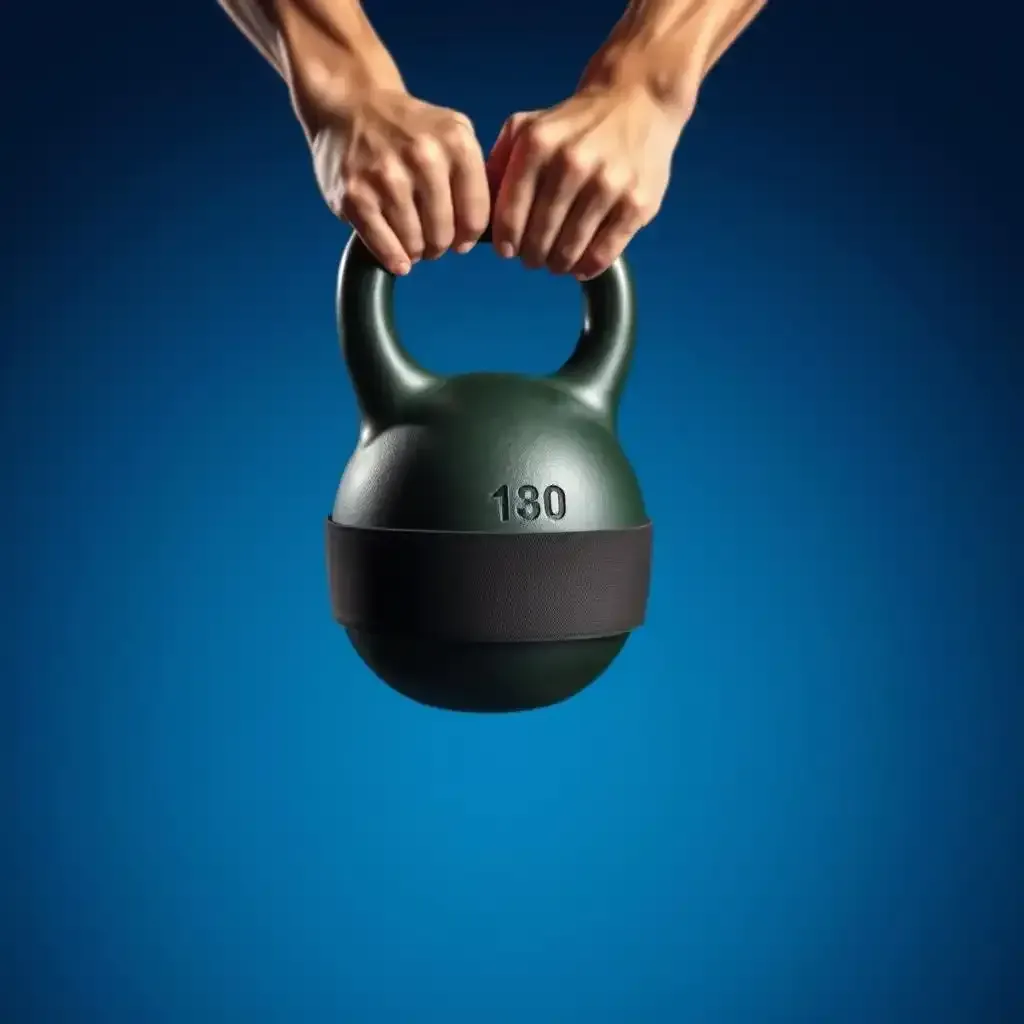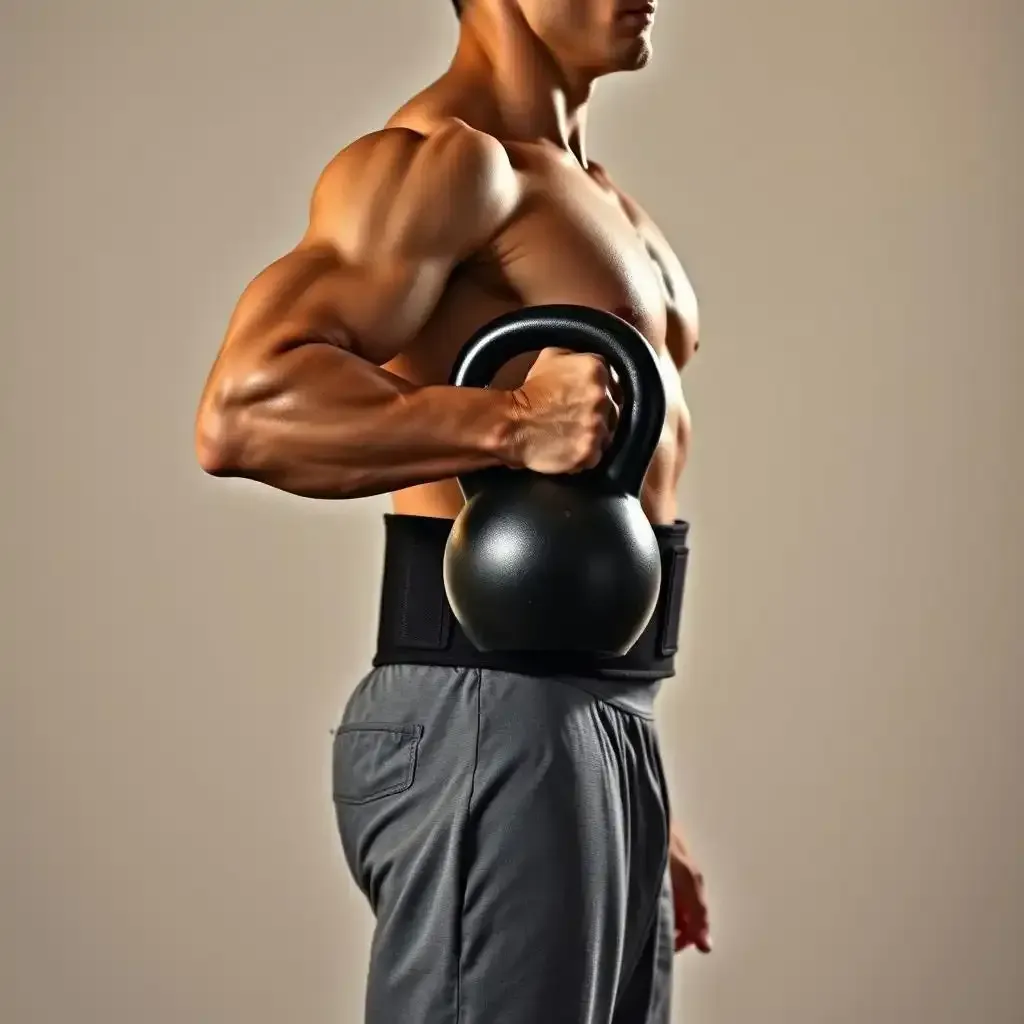Table of Contents
So, you're curious about using a belt with your kettlebell workouts? That's smart! Many kettlebell enthusiasts wonder if a belt is just a gimmick or a genuine game-changer. The truth is, it depends. This article, from kettlebellworkout.homes, will cut through the hype and give you the straight facts. We'll explore the benefits and drawbacks of using a kettlebell with a belt, focusing on specific exercises and situations where it shines, and where it might be unnecessary. We'll cover proper technique to ensure you're using the belt safely and effectively, and we'll even look at some advanced exercises that can be enhanced by incorporating a belt into your routine. Get ready to find how a simple piece of equipment can significantly impact your kettlebell progression.
Kettlebell with Belt: Finding Your Balance

Kettlebell With Belt Finding Your Balance
Why a Belt Matters
Imagine you're trying to hold a heavy kettlebell at the top of a jerk or long cycle. Your arms are shaking, and your core is screaming. That's where a belt comes in. A kettlebell belt acts like a support system for your lower back and core, helping you maintain stability and form. It's like having an extra pair of hands holding you up. Using a belt can significantly reduce the strain on your lower back, especially during heavy lifts. This is crucial because a weak lower back can lead to poor form, which increases the risk of injury. A sturdy belt can help you maintain a solid foundation, allowing you to focus on the movement rather than the pain.
Proper Belt Usage
Not just any belt will do. Kettlebell belts are specifically designed to provide a firm, rigid platform for your arms and shoulders. They are different from powerlifting belts, which are more flexible and designed for different movements. When choosing a kettlebell belt, look for one that fits snugly around your waist and is comfortable to wear during intense workouts.To use the belt effectively, follow these steps:1. **Position the Belt Correctly:** Place the belt around your waist, just above your hips. Make sure it’s not too high or too low.2. **Tighten It Properly:** The belt should be snug but not so tight that it cuts off circulation. You should be able to fit a finger or two between the belt and your skin.3. **Use It as a Shelf:** During exercises like the rack position, use the belt as a shelf to rest your elbows on. This helps keep your elbows from sliding off your hips and reduces fatigue.4. **Focus on Your Core:** Even with a belt, your core muscles are still doing most of the work. Engage your core and maintain good posture to get the most out of the belt.For a deeper investigate into kettlebell basics, check out our .
The Rack Position: A Key Player
One of the most important positions in kettlebell training is the rack position. This is where the kettlebell rests on the crook of your elbow and against your chest. It's a position you'll use a lot, especially in exercises like the clean and jerk.A belt can be a game-changer here. By providing a solid platform for your arms and shoulders, it helps you maintain the rack position for longer periods without fatigue. This is especially useful during endurance training or when you're working with heavier kettlebells.Think of it like this: without a belt, your arms and shoulders are like a wobbly table. With a belt, they're like a sturdy, reinforced table. The difference is clear, and your performance will show it.
When to Use a Kettlebell with Belt
Not every exercise requires a belt, but there are specific situations where it can make a big difference. Here are a few examples:- **Overhead Lifts:** Exercises like the military press or overhead squat benefit from the extra support a belt provides. It helps stabilize your core and keep your form in check.- **Rack Position:** As mentioned, the rack position is crucial in many kettlebell exercises. A belt can help you hold this position more effectively, reducing the risk of fatigue and injury.- **Heavy Weights:** When you're lifting heavy kettlebells, a belt can provide the additional support you need to perform the movements safely and effectively.However, it's important to note that a belt is not a cure-all. It's a tool, and like any tool, it should be used wisely. For simpler exercises like swings or goblet squats, a belt might not be necessary. In fact, using a belt for every exercise can make you overly reliant on it, which can weaken your core over time.For more tips on kettlebell workouts, check out our page.
Final Thoughts on Kettlebell with Belt
Using a kettlebell with a belt can be a game-changer for your training, but it's not a one-size-fits-all solution. Experiment with it, see how it feels, and remember to always prioritize proper form and technique. A belt is a tool to enhance your workouts, not a crutch to rely on.If you're new to kettlebell training, start with the basics and gradually incorporate a belt as needed. For more detailed guidance, check out our guide.
Kettlebell with Belt: Support and Stability

Kettlebell With Belt Support And Stability
How a Belt Strengthens Your Core
Imagine your core is like the foundation of a house. If the foundation is weak, the house wobbles and might even collapse. When you're lifting a heavy kettlebell, your core is under a lot of stress. This is where a belt comes in. It acts like a sturdy support beam, helping to reinforce your core and keep everything stable. Think about it: if you're doing a kettlebell jerk, your core needs to be rock-solid to handle the weight and the dynamic movement. A belt can help you maintain that stability, reducing the risk of strain and injury. For more on how to build a strong core, check out our guide.
Enhancing Your Form with a Belt
Using a belt isn't just about adding extra support; it's also about improving your form. When you're doing exercises like the long cycle or military press, your form can easily break down, especially under heavy loads. A belt can remind you to engage your core and keep your back straight. It’s like having a trainer right there with you, gently nudging you to keep your form in check.For example, when you're in the rack position, the belt provides a solid platform for your arms and shoulders. This helps you maintain a more upright posture, which is crucial for preventing shoulder and elbow injuries. If you're new to kettlebell training and need more tips on form, our can be a great resource.
Exercise | How the Belt Helps |
|---|---|
Kettlebell Jerk | Stabilizes the lower back and core |
Long Cycle | Provides a platform for the rack position |
Military Press | Keeps the core engaged and back straight |
Real-World Example: The Marathon Runner
Let’s say you’re a marathon runner who wants to incorporate kettlebell training to build core strength and improve endurance. You might start with the kettlebell jerk and long cycle. Without a belt, you might find your form breaking down after a few reps. But with a belt, you can maintain your form for longer, allowing you to push through more reps and build the endurance you need for your marathon. Using a belt can be a game-changer, but remember, it’s a tool, not a crutch. As you get stronger, you can gradually wean yourself off the belt to build a more robust and independent core. For more on how kettlebells can complement running, check out our article.
Mastering Kettlebell with Belt Techniques

Mastering Kettlebell With Belt Techniques
Hey there, fellow kettlebell enthusiast! Let's talk technique. I've found that using a kettlebell with a belt isn't just about strapping on extra support; it's about *smart* support. Think of it like this: your core is your engine, the belt is your trusty co-pilot. It helps keep everything running smoothly, especially when you're dealing with heavier weights or more complex movements.
One of my favorite things about using a belt is how it improves my form. It's like having a built-in reminder to keep my back straight and my core engaged. I used to struggle with my form during the long cycle, for instance, my back would round and I'd feel that strain. But with the belt, I naturally maintain a better position; it's almost like a gentle nudge towards perfect posture. It's amazing how much a little extra support can do for your technique. For more on proper form, check out our .
- Start slow and light. Don't jump into heavy weights right away. It's all about building confidence and getting used to the belt.
- Practice the rack position. This is where you'll be spending a lot of time, so get comfortable. The belt should feel secure, but not restrictive.
- Engage your core. The belt helps, but it doesn't do the work for you. Your core muscles are still the stars of the show.
- Listen to your body. If something doesn't feel right, stop. A little discomfort is fine, but pain is a red flag.
I've noticed a massive improvement in my overhead lifts since I started using a belt. Before, my shoulders would tire quickly, and I'd start compensating, losing form. Now? It's like magic. I can maintain proper form for longer and lift heavier weights. It's not about cheating; it's about optimizing. And for those tricky overhead squats? The belt is a lifesaver, providing that essential support to keep you upright and safe. For beginners, our are a great place to start.
Remember, the belt is a tool, not a crutch. It’s designed to assist, not replace, your own strength and stability. As you get stronger, you might find yourself using it less and less, but in the meantime, it's a fantastic way to improve your form and prevent injuries. Need some more tips? Check out our .
Exercise | Belt Use | Why It Helps |
|---|---|---|
Kettlebell Jerk | Yes | Supports lower back during explosive movement. |
Turkish Get-Up | Optional | Provides stability during transitions. |
Goblet Squat | No | Generally not needed for this exercise. |
Don’t be afraid to experiment. Find what works best for you. This is your fitness process, and you get to call the shots! And hey, if you're still feeling a little lost, take a peek at our – it's packed with helpful info for all levels.
I often hear people worry about becoming overly reliant on the belt. It's a valid concern! That’s why I recommend starting with lighter weights and gradually increasing the challenge as you gain confidence and strength. You want to use the belt to help you build strength, not to become dependent on it. Remember, the goal is a strong, stable core, and the belt is just one tool in your toolbox. For more ideas, check out our .
Kettlebell with Belt: When to Use (and When Not To!)
Okay, so you've got your snazzy new kettlebell belt. Fantastic! But when do you actually *use* the darn thing? It's not a magic cure-all, you know. I've seen people strap it on for everything, from simple swings to bicep curls. That's overkill! It's like wearing a life vest while taking a bath – unnecessary and possibly a little ridiculous.
Think of the belt as extra support for your core, like a supportive friend holding you up during a tough lift. It's amazing for those exercises where you’re really stressing your lower back and core. We're talking about overhead presses, snatches, and those intense long cycles. The belt stabilizes your trunk, so you can focus on the movement itself, not on preventing your spine from collapsing. For more on core exercises, check out our .
- Overhead lifts (like the press): The belt helps keep your posture perfect, preventing those sneaky shoulder injuries.
- Long cycles and cleans: These are intense, and the belt offers crucial lower back support.
- Heavy weights: When you’re pushing your limits, the belt provides that extra oomph to maintain stability.
But here's the deal: for moves like simple kettlebell swings or goblet squats, you probably don't need a belt. Using it for every exercise is a bad idea. It weakens your core muscles over time, making you reliant on the belt instead of building your own strength. It's like training wheels on a bicycle – great for learning, but eventually, you've got to take them off.
I remember when I first started using a belt. I was so excited, I wore it for *everything*. My core got lazy, and my form suffered when I tried to lift without it. Don't make the same mistake! Start by using the belt only when you need that extra support, and gradually work on strengthening your core so you become less dependent on it. For a great beginner's guide, check our .
Exercise | Belt? | Why (or why not)? |
|---|---|---|
Kettlebell Swing | No | Focuses on hip hinge; belt unnecessary. |
Turkish Get-Up | Optional | Can aid stability, but not essential. |
Military Press | Yes | Provides core support for overhead movement. |
It's all about finding that balance between support and building your own strength. Your body is amazing, and it's capable of incredible things. The belt is a tool to help you reach your full potential, not replace your own hard work. For more tips and tricks, head over to our page.
Remember, the most important thing is proper form. If you're unsure about anything, it's always best to start with lighter weights and focus on mastering the technique before adding extra equipment. And if you're feeling lost, check out our – it's a great starting point for building a solid foundation.
Final Thought
Ultimately, the decision of whether or not to use a kettlebell with a belt is a personal one. Experiment, listen to your body, and prioritize proper form above all else. A belt can be a valuable tool for specific exercises and individuals, but it's not a magic bullet. Remember to focus on building a strong core and mastering fundamental kettlebell techniques before relying heavily on external support. Happy lifting!